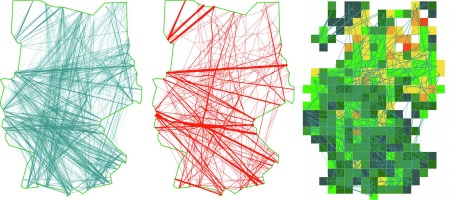Transportation Research Part C: Emerging Technologies ( IF 8.3 ) Pub Date : 2020-04-02 , DOI: 10.1016/j.trc.2020.102633 Ingrid Gerdes , Annette Temme , Michael Schultz

|
At present, en-route flight traffic is carried out on a system of predefined routes with a low number of intersections between aircraft trajectories. This enables the air traffic controllers to control and supervise the traffic, especially around these intersections. Consequently, the route system leads to a low ratio of used to unused airspace, where not necessarily the shortest route is used for each flight. To reduce trajectory length, the idea of free routing has been developed, whereby each aircraft uses the direct connection between origin and destination airport, generating a traffic distribution which uses nearly the entire available airspace. As a consequence, many intersections between flight trajectories occur, making it more difficult for controllers to handle. We use these intersections as the basis of a so-called main-flow system with trajectories consisting of intersection points instead of waypoints. The intersections of all trajectories of a traffic sample are clustered and the resulting cluster centres are used as nodes in a route system. Additional processing is applied to identify a system of main flows and reduce the number of intersections to an acceptable amount. Our approach is able to identify major traffic flows within unstructured great-circle traffic and to create a main-flow system which is a compromise between the flexibility of free routing and the easier surveillance by controllers in the case of a predefined route network. To prove the ability of the proposed method to identify main flows, it was applied to a scenario of planned flights following the standard route structure. Subsequent tests with two different free-routing scenarios led to new route systems where the median adapted trajectory length for flights of the traffic sample is merely 0.9% (respectively 4.1%) higher than the direct connections. Furthermore, structural complexity is lower for intersections (cluster centres) of the new main-flow system compared to those of direct or great-circle scenarios.
中文翻译:

从无限制的空中交通到经过调整的动态主流系统
目前,在飞机路线之间的交叉点数量少的预定路线的系统上进行途中飞行交通。这使空中交通管制员能够控制和监督交通,尤其是在这些交叉路口周围。因此,航线系统导致使用空域与未使用空域的比例较低,在这种情况下,不必为每次飞行都使用最短路径。为了减少弹道长度,已经开发了自由路由的想法,其中每架飞机都使用始发地和目的地机场之间的直接连接,从而产生几乎使用了整个可用空域的交通量分布。结果,在飞行轨迹之间发生许多相交,使得控制器更难处理。我们将这些相交点用作所谓的主流系统的基础,该系统的轨迹由相交点而不是航路点组成。交通样本的所有轨迹的交点被聚类,并且得到的聚类中心被用作路线系统中的节点。应用附加处理来识别主流系统,并将交叉点的数量减少到可接受的数量。我们的方法能够识别非结构化大圆环交通中的主要交通流,并创建一种主流系统,该系统在自由路由的灵活性与在预定义路由网络的情况下控制器更易于监视之间做出了折衷。为了证明所提出的方法识别主要流程的能力,将其应用于遵循标准航线结构的计划飞行方案。随后在两种不同的自由路由场景下进行的测试导致了新的航线系统,在该航线系统中,交通样本的飞行适应轨迹长度的中位数仅比直接连接高0.9%(分别为4.1%)。此外,与直接或大圆情景相比,新主流系统的交叉路口(集群中心)的结构复杂度更低。


























 京公网安备 11010802027423号
京公网安备 11010802027423号